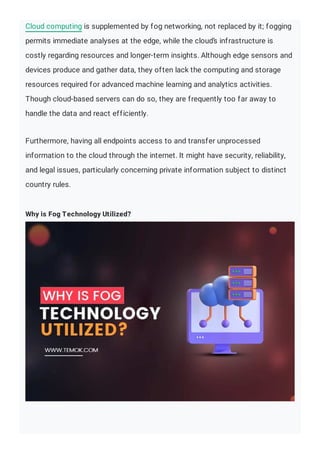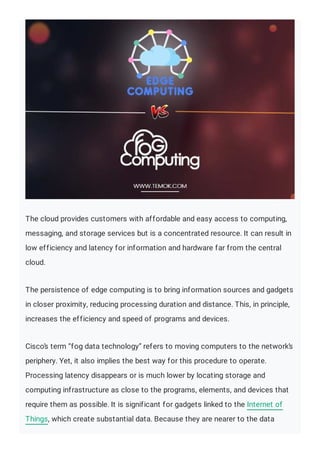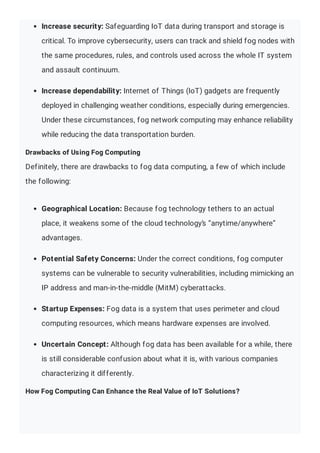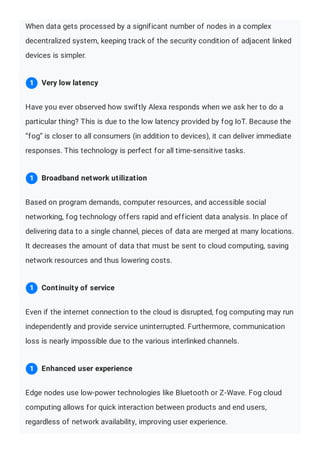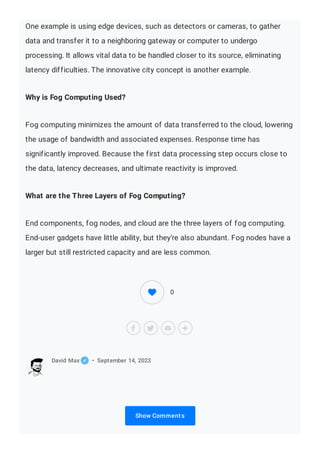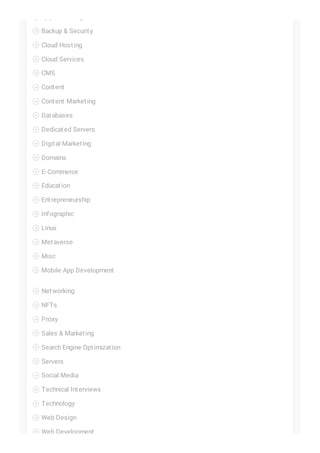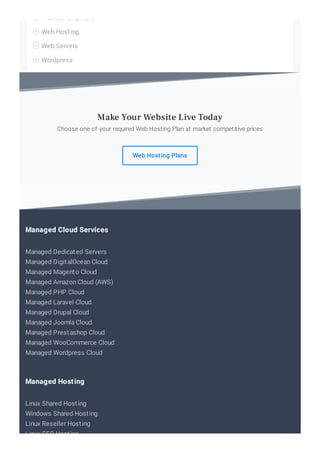The Future of Fog Computing and IoT: Revolutionizing Data Processing
- 1. Sending a business e-mail, watching a YouTube video, making an online video call meeting, or playing a video game online requires considerable data flow. It necessitates such massive data flow in the direction of servers in data centers. Cloud computing prefers remote data processing and substantial storage systems to develop online apps we use daily. But we must know that other decentralized cloud computing systems exist. Fog computing technology is growing wildly in popularity. As per fog technology experts, the global fog technology market will reach nearly $2.3 billion at the end of 2032. The market for fog technology was $196.7 million at the end of 2022. Quick advances in information technology have already empowered suppliers or manufacturers to implant microchips and sensors. It will improve the liability and performance of various goods and services like home appliances, road vehicles, and agricultural machinery. David Max Posted on September 14, 2023 8 min read • Home • Community Posts The Future of Fog Computing and IoT: Revolutionizing Data Processing
- 2. Keep reading the article to learn how the fog network is changing the world and what the future will look like. What is Fog Computing? Fog computing is a type of distributed computer system in which data, computing power, storage, and software have a distributed system between the data sources and the cloud. Fog technology, similar to edge computing, delivers the benefits and capability of the cloud nearer to where data originates and reacts. Because both involve moving intellect and processing farther from where the information occurs, many people indiscriminately use the words fog processing and edge computing. It is frequently done to increase productivity but may be carried out due to safety and regulation concerns. The fog metaphor is derived from the atmospheric term, meaning a cloud near the ground, precisely as fog accumulates on the network’s edge. The name will link frequently with Cisco; Ginny Nichols, the business’s line of goods manager, is thought to have created it. Cisco Fog data computing is a trademark; fog technology is available to the general public. What Does Fog Computing Actually Work? Table of Contents 1. What is Fog Computing? 2. What Does Fog Computing Actually Work? 3. Why is Fog Technology Utilized? 4. Edge Computing Vs. Fog Computing 5. What Are The Fog Computing Benefits? 6. Drawbacks of Using Fog Computing 7. How Fog Computing Can Enhance the Real Value of IoT Solutions? 8. Conclusion 9. FAQs (Frequently Asked Questions)
- 3. Cloud computing is supplemented by fog networking, not replaced by it; fogging permits immediate analyses at the edge, while the cloud’s infrastructure is costly regarding resources and longer-term insights. Although edge sensors and devices produce and gather data, they often lack the computing and storage resources required for advanced machine learning and analytics activities. Though cloud-based servers can do so, they are frequently too far away to handle the data and react efficiently. Furthermore, having all endpoints access to and transfer unprocessed information to the cloud through the internet. It might have security, reliability, and legal issues, particularly concerning private information subject to distinct country rules. Why is Fog Technology Utilized?
- 4. Fog technology computing has numerous possible applications. Traffic management is a growing scenario for fog networks. Because detectors, such as those that track traffic, are frequently linked to wireless networks, cities may place computing facilities near cell towers. These processing abilities allow the immediate analysis of traffic data, allowing traffic signals to adjust to changing circumstances in real time. This fundamental notion uses fog technology in self-driving cars. Self-driving cars operate as edge devices because of their massive onboard computer capability. These cars must be capable of absorbing data from many sensors, analyzing real-time data, and responding appropriately. Because a self-driving vehicle intends to function without a requirement for internet access, it’s easy to dismiss them as unconnected devices. Even though a self-driving vehicle must operate adequately, despite the lack of cloud connectivity, the connection is used when it is accessible. Some communities consider how a self-driving vehicle may run using the same computer power to regulate traffic signals. For example, a car of this type could act as an edge device, communicating real-time information to a system that receives traffic data from additional sources. The fundamental computing infrastructure can utilize this data to control roadway signals more efficiently. Also Read: Hosted VS Cloud Services: Key Differences; How Does It Work? Edge Computing Vs. Fog Computing
- 5. The cloud provides customers with affordable and easy access to computing, messaging, and storage services but is a concentrated resource. It can result in low efficiency and latency for information and hardware far from the central cloud. The persistence of edge computing is to bring information sources and gadgets in closer proximity, reducing processing duration and distance. This, in principle, increases the efficiency and speed of programs and devices. Cisco’s term “fog data technology” refers to moving computers to the network’s periphery. Yet, it also implies the best way for this procedure to operate. Processing latency disappears or is much lower by locating storage and computing infrastructure as close to the programs, elements, and devices that require them as possible. It is significant for gadgets linked to the Internet of Things, which create substantial data. Because they are nearer to the data
- 6. source, these devices have significantly reduced latency in fog network computing. Another distinction between the use of edge computing and fog network computing is that fog is a typical system that allows consistent, arranged, and expandable performance under the edge computing framework. Edge computing is a subset of fog network computing in which data is generated, processed, and stored nearby. Edge processing is included in fog computing, as is the requisite equipment and network links for conveying the data. What Are The Fog Computing Benefits? Fog benefits are numerous and beneficial for experts. The use of fog data technology can bring plenty of advantages. Fog technology, like any other
- 7. technological advances, has advantages and disadvantages. The following are some of the fog benefits you must know about: Bandwidth Management: Fog network computing minimizes the amount of data transferred to the cloud, lowering usage of bandwidth and associated expenses. Increased Response Time: Because the first data processing occurs close to the data, latency decreases and improves overall reactivity. The objective is to deliver millisecond-level adaptability, allowing for data processing in near-real time. Network-Agnostic: A fog network often provides computational horsepower through the local area network level rather than the product level, as is the case for edge computing. The network has a link, which is part of the fog processing infrastructure. Reduce latency: Keeping evaluation close to the information source reduces compounding system breakdowns, production line outages, and other serious difficulties. The capacity to undertake real-time data analysis implies faster alarms, fewer risks for consumers, and less time lost. Reduce broadband network consumption: Many statistical analysis jobs, even essential analyses, may not necessitate the scalability that cloud- based data storage and processing provides. Meanwhile, connected gadgets create an increasing amount of data for study. Fog data reduces the need to transport most of this massive data, freeing up resources for other vital tasks. Reduce operating expenses: Lower operating costs result from analyzing as much data regionally as feasible and preserving the network’s bandwidth.
- 8. Increase security: Safeguarding IoT data during transport and storage is critical. To improve cybersecurity, users can track and shield fog nodes with the same procedures, rules, and controls used across the whole IT system and assault continuum. Increase dependability: Internet of Things (IoT) gadgets are frequently deployed in challenging weather conditions, especially during emergencies. Under these circumstances, fog network computing may enhance reliability while reducing the data transportation burden. Drawbacks of Using Fog Computing Definitely, there are drawbacks to fog data computing, a few of which include the following: Geographical Location: Because fog technology tethers to an actual place, it weakens some of the cloud technology’s “anytime/anywhere” advantages. Potential Safety Concerns: Under the correct conditions, fog computer systems can be vulnerable to security vulnerabilities, including mimicking an IP address and man-in-the-middle (MitM) cyberattacks. Startup Expenses: Fog data is a system that uses perimeter and cloud computing resources, which means hardware expenses are involved. Uncertain Concept: Although fog data has been available for a while, there is still considerable confusion about what it is, with various companies characterizing it differently. How Fog Computing Can Enhance the Real Value of IoT Solutions?
- 9. IoT and end consumers are growing more powerful. A significant proportion of data is underway instantly on the cloud. In addition, here are six advantages that fog technology can provide to the IoT app development procedure: You can create fog apps and deploy these whenever necessary with the correct tools. Such programs configure the device to work as desired by the user. The fog network system functions as an intermediary for devices with limited resources, updating their software and secure credentials. It delivers fog nodes with the same policies, procedures, and controls utilized throughout the IT infrastructure. Enhanced company flexibility 1 Increased security 1
- 10. When data gets processed by a significant number of nodes in a complex decentralized system, keeping track of the security condition of adjacent linked devices is simpler. Have you ever observed how swiftly Alexa responds when we ask her to do a particular thing? This is due to the low latency provided by fog IoT. Because the “fog” is closer to all consumers (in addition to devices), it can deliver immediate responses. This technology is perfect for all time-sensitive tasks. Based on program demands, computer resources, and accessible social networking, fog technology offers rapid and efficient data analysis. In place of delivering data to a single channel, pieces of data are merged at many locations. It decreases the amount of data that must be sent to cloud computing, saving network resources and thus lowering costs. Even if the internet connection to the cloud is disrupted, fog computing may run independently and provide service uninterrupted. Furthermore, communication loss is nearly impossible due to the various interlinked channels. Edge nodes use low-power technologies like Bluetooth or Z-Wave. Fog cloud computing allows for quick interaction between products and end users, regardless of network availability, improving user experience. Very low latency 1 Broadband network utilization 1 Continuity of service 1 Enhanced user experience 1
- 11. Conclusion Fog computing is a cloud partner that handles enormous quantities of data set up daily by the Internet of Things or IoT technology. As previously said, data processing more closely to the source of information overcomes the issues of increasing data volume, speed, and variety. It provides companies with more oversight over their customer information. Fog data technology also speeds up awareness of and response to occurrences. It removes the need for any analysis to be performed in the cloud. That indicates there will be no more costly connection bandwidth issues in the Internet of Things responses and no need to unload large amounts of info onto the leading network’s infrastructure. As it analyzes critical Fog IoT data inside an organization’s antivirus programs, fog network also seeks to protect it. It eventually enhances company versatility, improved safety, and superior service levels. Comment down your valuable queries about fog data computing and get your answers accordingly. FAQs (Frequently Asked Questions) What is Fog Computing vs Edge Computing? Edge computing helps endpoints get quicker outcomes by analyzing the data that arrives at the devices concurrently. By delivering the reduced data, fog computing assists in filtering pertinent details from the vast amount of data gathered by the device and saving it in the cloud. What is an example of a Fog Computing Devices?
- 12. One example is using edge devices, such as detectors or cameras, to gather data and transfer it to a neighboring gateway or computer to undergo processing. It allows vital data to be handled closer to its source, eliminating latency difficulties. The innovative city concept is another example. Why is Fog Computing Used? Fog computing minimizes the amount of data transferred to the cloud, lowering the usage of bandwidth and associated expenses. Response time has significantly improved. Because the first data processing step occurs close to the data, latency decreases, and ultimate reactivity is improved. What are the Three Layers of Fog Computing? End components, fog nodes, and cloud are the three layers of fog computing. End-user gadgets have little ability, but they’re also abundant. Fog nodes have a larger but still restricted capacity and are less common. Show Comments David Max • September 14, 2023 0
- 13. Blog Categories Before anyone else does Register Now Register Your Domain Get the latest news and deals Join our subscribers list to receive latest blogs, updates and special offers delivered directly in your inbox. Your Name john.doe@gmail.com join the list App App Marketing
- 14. pp g Backup & Security Cloud Hosting Cloud Services CMS Content Content Marketing Databases Dedicated Servers Digital Marketing Domains E-Commerce Education Entrepreneurship Infographic Linux Metaverse Misc Mobile App Development Networking NFTs Proxy Sales & Marketing Search Engine Optimization Servers Social Media Technical Interviews Technology Web Design Web Development
- 15. Web Development Web Hosting Web Servers Wordpress Choose one of your required Web Hosting Plan at market competitive prices Web Hosting Plans Make Your Website Live Today Managed Dedicated Servers Managed DigitalOcean Cloud Managed Magento Cloud Managed Amazon Cloud (AWS) Managed PHP Cloud Managed Laravel Cloud Managed Drupal Cloud Managed Joomla Cloud Managed Prestashop Cloud Managed WooCommerce Cloud Managed Wordpress Cloud Managed Cloud Services Linux Shared Hosting Windows Shared Hosting Linux Reseller Hosting Linux SEO Hosting Managed Hosting
- 16. Linux SEO Hosting Domains Linux Virtual Private Server (VPS) Windows Virtual Private Server (VPS) SEO RDP/VPS Proxies VPN SSL About Us Contact Us Privacy Policy Terms & Conditions Service Level Agreement DMCA Acceptable Use Policy Blog Affiliates Company Subscribe Sign up for special offers: Newsletter
- 17. © Copyright TEMOK 2023. All Rights Reserved.


